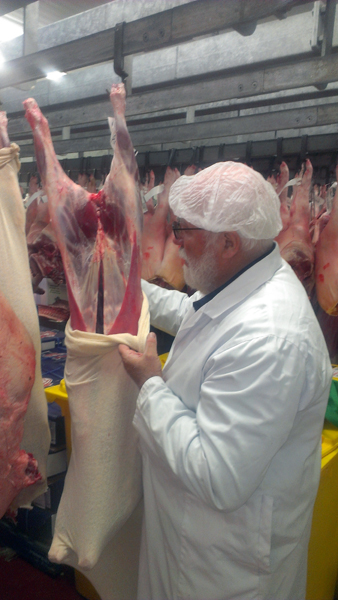All of our lamb is dry-aged for a minimum of 7 days which concentrates the natural flavours of the lamb and tenderises the meat’s texture. We produce lamb that is full of flavour and completely natural.
 Dry-ageing is an involved process as it requires the lamb carcass to be sleeved in cheese-cloth and ‘hung’ and stored for extended periods in near freezing temperatures. Because of this, dry-aged lamb is rarely available outside of speciality butchers that stock Moore River Lamb. All of our lamb is dry-aged for at least 7 days to ensure superior tenderness and flavour.
Dry-ageing is an involved process as it requires the lamb carcass to be sleeved in cheese-cloth and ‘hung’ and stored for extended periods in near freezing temperatures. Because of this, dry-aged lamb is rarely available outside of speciality butchers that stock Moore River Lamb. All of our lamb is dry-aged for at least 7 days to ensure superior tenderness and flavour.
Dry-ageing involves the following processes:
We dry-age our lamb to help tenderize the lamb-meat texture and to concentrate, saturate and infuse the lamb-meat with additional natural flavour. The dry-ageing process starts when the moisture is evaporated from the muscle – this creates a greater concentration of lamb flavour and taste. Secondly, the enzymes that occur naturally in the lamb meat begin to break down the meat’s proteins, fats, and glycogen into amino acids, fatty acids and sugars and this process helps tenderise the lamb-meat.
Dry-aged lamb is rarely available in Australia because it takes time and there can be some loss of weight during the ageing process – typically up to 5% or more of the weight is lost as moisture, depending on the fat score of the lamb’s carcass. Dry-aged lamb-meat is still juicy when you cook it, but the juices are even more flavoursome and delicious than usual.
Wet-aged lamb is lamb that has typically been aged in a vacuum-sealed bag (CV Packed) to retain its moisture. CV packed lamb has an extended shelf life of c. 2-3x weeks – if the CV package has not been opened in that time it should be frozen for later use. When opened, the CV packaged cut will often have a noticeable odour which generally dissipates within moments – if the odour lingers the meat should be washed and patted/rubbed dried and left to air before cooking. The odour signifies that the ageing is working and that the meat proteins/fats/glycogen are being broken down and that the lamb meat is being tenderized and flavours are being intensified.
At Moore River Lamb we CV pack our lamb cuts when making our ½ (c. 10kg.) and ¼ (c. 5kg.) bulk ‘lamb boxes’ – however, our ‘boxed’ lamb is always dry-aged for 7 days before each of the separate cuts are vacuum-sealed and wet-aged.